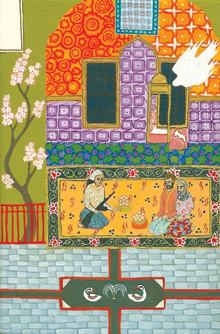
‘LAST SUPPER’ Egg tempera on birch panel, by Alina Gallo, 6 by 4 inches, 2012. |
Alina Gallo, a MECA MFA alumna with an academic background in writing and literature, is the artist behind "Rising," a modestly sized but stimulating collection of interpretive works — call them studies — that re-envision intersections of Western and Islamic culture both recent and ancient. She is also one of the few Maine visual artists to address the Arab Spring — a subject "Rising" takes as its main topic — which establishes a firm footing for some of Gallo's more fanciful designs, in which she boldly redesigns the exteriors of several prominent Western edifices with the florid, illustrative patterns of medieval Islamic art.In the tiny, utilitarian gallery (and shop) at Art House Picture Frames, Gallo's show contains three distinct series — four if you count a single wood-and-clay plinth, the show's only three-dimensional piece, painted in three busy Persian patterns with a disharmonious color scheme. Among all the approaches found in her works, one variable remains fixed: Gallo performs each of these studies using egg tempera, an early painting technique that allows for precise brushstrokes and hatches and a matte finish without color fade (the yolk and paint emulsion becomes insoluble when it dries). Tempera was the primary process in pre-Renaissance painting before the oil medium was introduced in the 15th century, and Gallo's panels observe this fact astutely as they revive an ancient form.
Far and away the strongest pieces in "Rising" are five recent birch panels in Persian miniature style. The Persian miniature — usually figurative scenes characterized by resplendent colors, precise narrative detail, and a high spatial horizon — is a cornerstone of Islamic art dating to the 14th century; Gallo has revitalized it beautifully, borrowing from the tradition to portray several harrowing snapshots from the region's recent tumult. In one titled "Mohamed Bouazizi," she has rendered the moment of the Tunisian merchant's self-immolation in protest of his suppression by state officials, an act that helped galvanize the Tunisian Revolution and the later Arab Spring. "Kandahar Massacre" depicts a grim scene from March of this year, when a US Army soldier was charged with killing 17 civilians in the Kandahar province of Afghanistan. Two salient white chambers hover in its left column as if gesturing to the deceased.
"The Last Supper" and "Out of Syria" tell of US foreign correspondents Anthony Shadid and Tyler Hicks — who were captured and detained in 2011 while covering the Libyan Civil War — in their attempt to leave Syria earlier this year (during which Shadid suffered a fatal asthma attack). In the former, the two men sit for a tense meal with an armed woman while a diaphanous white mass hovers overhead. In the latter, they attempt to navigate a mountain range as a figure (presumably Shadid) slumps over his horse, Gallo's familiar white chambers merging into the scene.
Others of her miniatures, from 2010, are also on display, illustrating the arc of Gallo's studious artistic development. They foreground less colorful, largely non-figurative scenes in mountains and steppes, but teeming beyond the horizon is a throng of human heads, a powerful symbol of the revolutionary wave that hit in the tail end of that year.